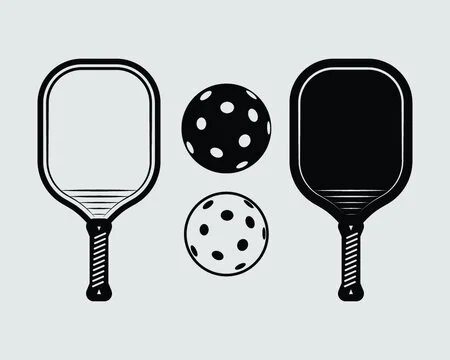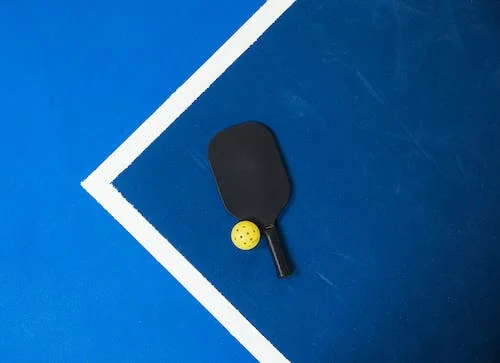
Pickleball paddle has 3 parts face, core, handle. The materials to make these parts can be various. Each material used gives the paddle different characteristics.
This article explains the differences for each material that used to make pickleball paddles.
Best Pickleball Paddles for Beginners
Nowadays, there are so many pickleball paddles sold in sports stores or online markets. If you are just starting to play pickleball and want to choose the best pickleball paddle for you, you can choose the one that is most comfortable to hold. That will vary from person to person, but most beginners prefer to start with a mid-range paddle that has a large surface area and medium thickness.
In choosing a pickleball paddle, you can consider several things such as shape, thickness, grip comfort, weight, good control over power and spin.
What are Pickleball Paddles Made of?
Pickleball paddles can be made of various materials, not only one material but also a combination of several materials to maximize its use.
At the core, it is usually made of lightweight material and is able to absorb vibrations when hitting the ball. The face of the pickleball paddle is the part that will be in direct contact when hitting the ball, so a solid and strong material is needed so that the strength of the blow becomes maximized.
Then the handle, this part acts as a control center for each hit made. Usually using materials that are comfortable to hold and not slippery when wet. Here are some materials commonly used to make pickleball paddles.
Wooden
Wood is a very common material used because it is strong and can be molded into various shapes. Some woods such as maple, mahogany, alder and balsa are often used in making pickleball paddles. The wood is chosen because it is not too heavy and still strong to be used as the basic material of the pickleball paddle.
Here’s a brief explanation:
– Maple: Light to medium weight; Medium power
– Mahogany: Medium weight; High power
– Alder: Medium weight; High power
– Balsa: Light weight; Low power
The wood materials used for pickleball paddles generally have advantages and disadvantages as follows:
Pros
- Affordable, The price of pickleball paddle with wood material is cheaper than other materials.
- Classic feel, Wood gives a traditional impression and this material has a characteristic when used.
- Durable, although cheap, wood has solid properties so that it has good enough resistance to light impact and average use.
Cons
- Weight. Although some types of wood have a medium or even light weight. When compared to other materials, wood is still heavier.
- Limited sweet spot. The ideal hitting area on a wooden paddle is smaller, this causes difficulty when playing because the stroke becomes inconsistent if it does not hit the sweet spot correctly.
- Sensitive to moisture. Wood can absorb moisture, which can affect the weight and performance of the paddle. It is recommended to store the wooden paddle in a dry and cool place.
You can choose pickleball paddle with wooden material according to your preference and comfort. Or you can look at some other materials to compare.
Pickleball Paddle from Graphite
Currently, pickleball paddles made from graphite are quite popular. Because it has various advantages over other materials. However, this material is usually used in the high-end class and the price is quite expensive. Graphite paddle is made of lightweight and strong material. It provides a balance between power and control when used.
Some pros and cons of graphite paddle.
Pros :
- Lightweight : Graphite is an incredibly light material that increases paddle control and allows you to swing faster. This is especially beneficial for players who value speed and agility on the court.
- Powerful : Despite its light weight, graphite transfers power efficiently for powerful, impactful strikes. Therefore, it is popular with pickleball players who want to create powerful smashes and drives.
- Large Sweet Spot : graphite paddles often have a larger sweet spot than paddles made from other materials. This means you can experience more consistent performance and power even on off-center hits.
- Durability : Despite its light weight, graphite is incredibly durable. Modern pads that combine graphite with other materials such as honeycomb core provide superior abrasion and tear resistance.
Cons :
- Expensive: Graphite paddles are generally more expensive than paddles made from other materials such as wood or fiberglass. This can be a disadvantage for beginners or players on a limited budget.
- Hard Feel: Some players find the stiffness of the graphite racket undesirable, especially when compared to the soft feel of wood. This may take some getting used to and may not be ideal for everyone.
- Vibration: Some graphite rackets can transmit more vibration than other materials, which can cause discomfort in the elbows and arms after long periods of play.
- Temperature Sensitivity: Like aluminum, graphite is slightly sensitive to temperature changes, which can affect the feel and performance of the paddle in extreme weather conditions.
Composite
Composite paddles are made from a mixture of several materials such as graphite, fiberglass, and carbon fiber. This composite material has a lighter weight than wood but heavier than graphite.
Right away, here are the pros and cons :
Pros :
- Good balanced : composite material provides the perfect balance of aggressive power and precise control for superior performance on both shots and volleys.
- Comfortable Feel: Unlike hard graphite racquets, the composite material has a soft feel that many players find more comfortable, especially during long periods of play.
- Versatility and Affordability: composites come in a variety of price points and styles, so you’re sure to find something to suit your budget and gaming preferences.
Cons :
- Heavier than pure graphite: Compared to the highest grade graphite paddles, composite materials feel slightly less maneuverable and can affect agility and hand speed.
- Sweet Spot Size: Some composites have a larger sweet spot than graphite paddles, but may not be as large as the best graphite options and require more precise contact for optimal performance.
- Potential for Decreased Performance: While composite materials offer superior performance, they may not be able to produce the same explosive impact as a high quality graphite paddle.
Carbon Fiber
Carbon fiber is a material that we often encounter when choosing a pickleball paddle. This material has very strong but light properties. This can maximize the power of the stroke on the paddle.
There are various uses for carbon fiber. The following is the explanation
- All Carbon Fiber Paddle: This is a high-end pure paddle with carbon fiber face and core.
Benefits: outstanding performance, stiff for precise control, lightweight for agility.
Cons : Expensive, can have a rough feel, tends to chip, and has excellent vibration transmission.
Common use : Advanced players looking for maximum power and control.
- Paddle with carbon fiber surface: This is a more common scenario where the surface is carbon fiber and the core is made of another material such as honeycomb polypropylene.
Benefits: combines the benefits of carbon fiber (performance, control) with the benefits of core material (comfort, vibration damping).
Cons: Depending on the core material, it is still relatively expensive compared to non-carbon options.
Common use : Intermediate and advanced players looking for a balance of power, control and comfort.
- Paddles Containing Carbon Fiber: Some paddles may have a small amount of carbon fiber woven into the face or core along with other materials.
Benefits of : offers some of the benefits of carbon fiber (stiffness, strength) at a lower price.
Cons: Limited power and control compared to the pure carbon option.
Common use for : Beginners and recreational players who want to go one step further from a basic racket.
Alumunium
It is not commonly used but can still be an option when you choose the material for your pickleball paddle. If you want to use aluminum, you need to consider the following advantages and disadvantages.
Pros :
- Lightweight : aluminum is an incredibly lightweight material, significantly lighter than non-metallic paddles. This greatly improves maneuverability and swing speed.
- Durability : aluminum has excellent strength and durability, preventing warping, cracking, and chipping, which are common problems with wooden paddles.
- Unique Feel : In contrast to traditional materials, aluminum provides a special gaming experience.
Cons :
- Decreased Power : Aluminum is not inherently weak, but it does not produce as much power as other materials such as carbon fiber.
- Temperature Sensitivity : aluminum is sensitive to temperature changes, which can affect the feel and performance of the paddle. This can be noticeable in extreme weather conditions.
- Less Common : Finding quality aluminum paddles on the market can be a little more difficult than more common materials.
Best Material for Pickleball Paddles

After knowing all the materials above. Which material is the best for making a pickleball paddle? As explained above. Each material has its own advantages and disadvantages. And everyone also has their own preferences in choosing materials for their pickleball paddle. So, the best material is the one that best suits your needs and desires.
If you are a beginner, you should choose a standard material first such as wood, or composite to practice strength and control on the paddle. For intermediate to advanced levels, you can use higher quality materials to maximize your potential.
How to Choosing the Right Pickleball?
Now, how to choose the right pickleball paddle? The first thing you should do is to know your game needs. You need to analyze your style of play, aggressive attacking or not. If you prefer aggressive attacking then you need a paddle with strong material that can maximize the additional power for you.
Next, prioritize comfort. Choose a material that keeps you comfortable even if you play for a long time. You can choose a material that can give you an advantage during long games.
Finally, don’t be afraid to choose a pickleball paddle with a combination of materials. Because the combination of materials can give you more advantages when competing.
Conclusion
Pickleball paddles use various materials for the core, face, and handle, each serving a specific purpose. The core, made of lightweight substances like polymer or aluminum, enhances responsiveness and power. The face requires robust materials such as graphite or carbon fiber for strength and maneuverability. The handle prioritizes comfort. Wood, graphite, composite materials, carbon fiber, and aluminum are all employed, each with distinct advantages and considerations, catering to diverse player needs.
When choosing the right pickleball paddle, players need to assess their playing style and preferences. For aggressive players seeking power, a sturdy material like graphite may be suitable, while comfort remains a priority for those engaging in extended play. Beginners may opt for standard materials like wood or composite to practice strength and control, while intermediate to advanced players can explore higher-quality materials to maximize their potential.
The selection process involves understanding individual playing needs, prioritizing comfort, and considering material combinations for a competitive edge on the court.
Please comment and like below if you like this article.

